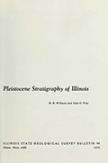Historical:Peyton Colluvium
Lithostratigraphy: Peyton Colluvium
Chronostratigraphy: Cenozoic Erathem >>Quaternary System >>Holocene Series
Authors
H. B. Willman and John C. Frye
Name origin
The Peyton Colluvium is named for Peyton Creek, which crosses an area of the formation that is mapped as slopewash and alluvial fans (Wanless, 1957) at the base of the Illinois Valley bluffs 1.5 miles southwest of Glasford, NW NE Sec. 32, T. 7 N., R. 6 E., Peoria County. It is here classified as a formation.
Lithology
It includes the widely distributed but narrow belts of poorly sorted debris that accumulated at the base of steep slopes, largely by creep and slopewash. The numerous small alluvial fans and cones that occur at nearly every gully and grade into slopewash deposits are included in the formation. The material is dominantly a pebbly silt, but its composition depends on the material in the bluffs above. Along loess-mantled bluffs it appears to grade upward into loess by decrease in the abundance of pebbles. At its lower margin the colluvium grades or interfingers into the stream or river alluvium, but the Peyton Colluvium is separated from the Cahokia Alluvium by vertical cutoff.
References
WANLESS, H. R., 1957, Geology and mineral resources of the Beardstown, Glasford, Havana, and Vermont Quadrangles: Illinois State Geological Survey Bulletin 82, 233 p.
ISGS Codes
| Stratigraphic Code | Geo Unit Designation |
|---|---|
